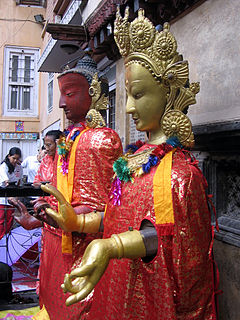Goon lā
|
|
|
|---|---|

Statues of Dipankara Buddha on display during Gunlā in Kathmandu
|
|
| Also called | Gunlā Parva in Nepali |
| Observed by | Nepalese Buddhists |
| Type | Religious |
| Significance | Celebrates rains retreat started by the Buddha |
| Observances | Image displays, musical processions, alms distribution, fasting, prayer |
Gunlā (Nepal Bhasa: गुंला) (also spelt Gumlā) is the tenth month in the Nepal Sambat lunar calendar, the national lunar calendar of Nepal. It corresponds to August of the Gregorian Calendar.
Gunla is a holy month for Newar Buddhists when they recite the scriptures, observe fasts and visit places of worship playing devotional music. It is one of the most important events in Newar Buddhism. The practice of observing the sacred month is descended from the rains retreat dating from the Buddha's time when monks stayed in one place and taught the Dharma.
Devotees mark the holy month by making daily early morning pilgrimages to Swayambhu in Kathmandu and other Buddhist temples playing Gunla Bajan music. The musical bands represent various localities of the city.
The devout recite the scriptures at home and sacred courtyards. Some undergo fasting. Another devotional activity during Gunla is Dyah Thāyegu (द्यः थायेगु) when devotees make little stupas out of black clay using a mold.
Panjaran (पन्जरां) is the alms giving festival. Males of the Bajracharya and Shakya castes make an alms round of the city and devotees give them rice and money. Shrines are set up with Buddha statues and paubha scroll paintings at private homes, courtyards and on the roadsides from where the gifts are distributed. The event is held on different dates in Kathmandu valley and Lalitpur.
On the first day of the second fortnight of Gunla, large images of the Dipankara Buddha and paubha paintings are put on display in sacred courtyards. The ceremony is known as Bahidyah Bwayegu (बहीद्यः ब्वयेगु).
...
Wikipedia
